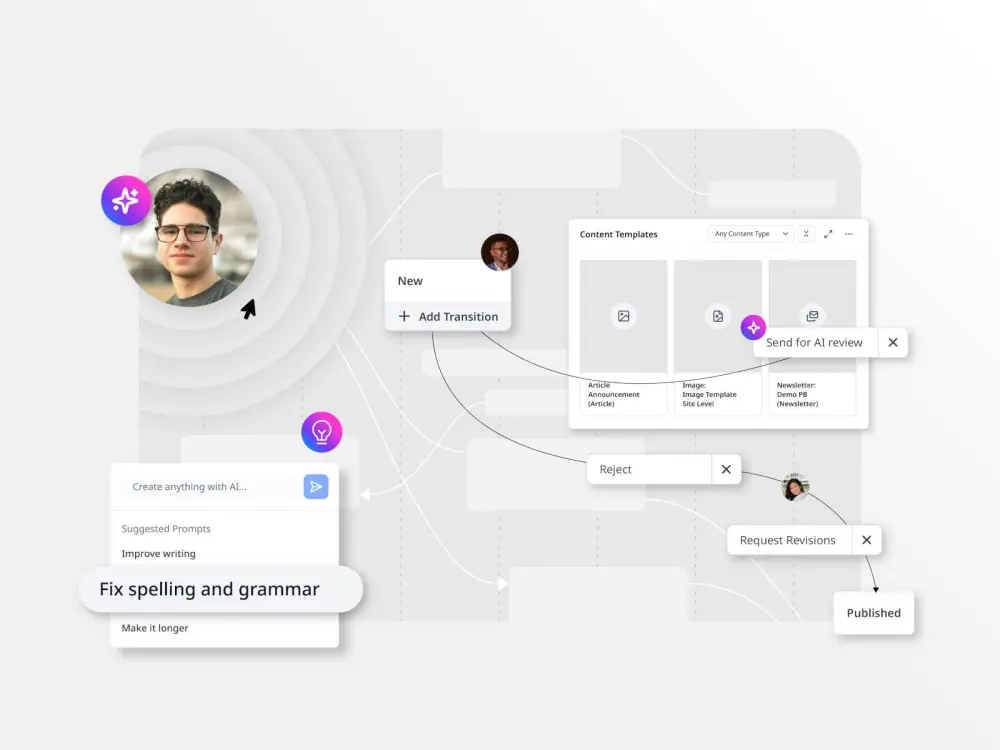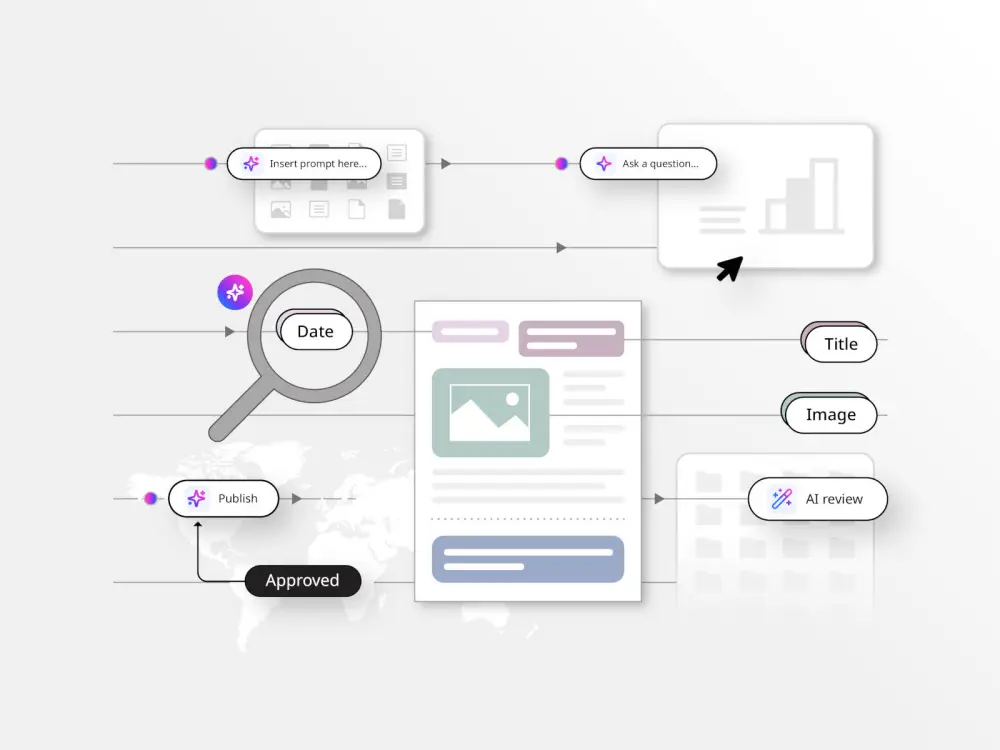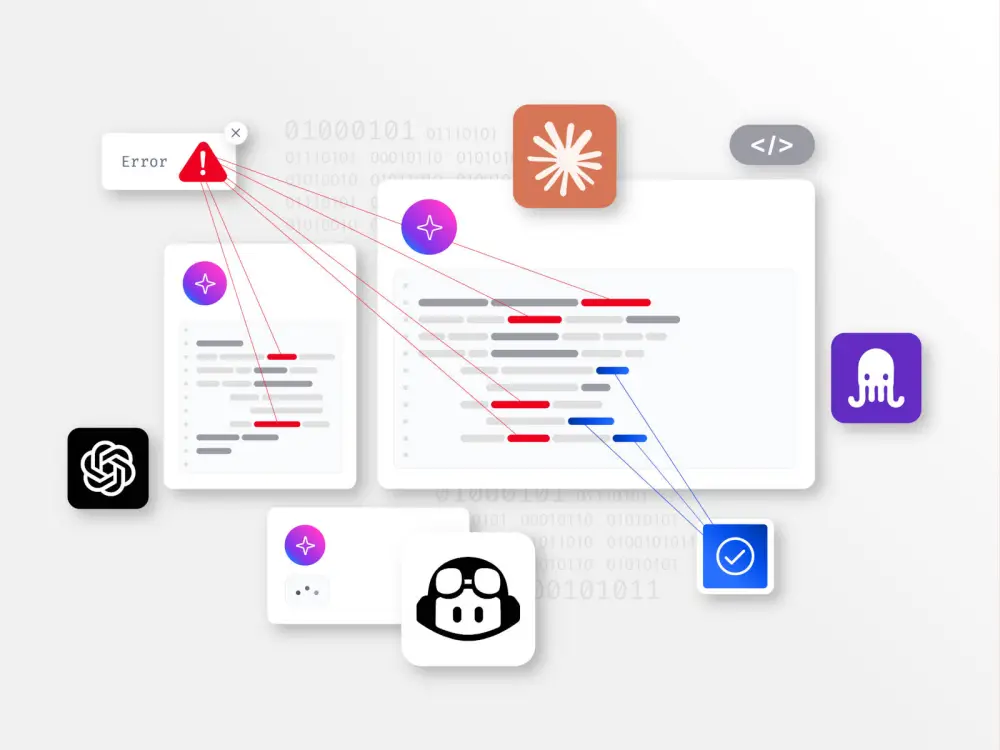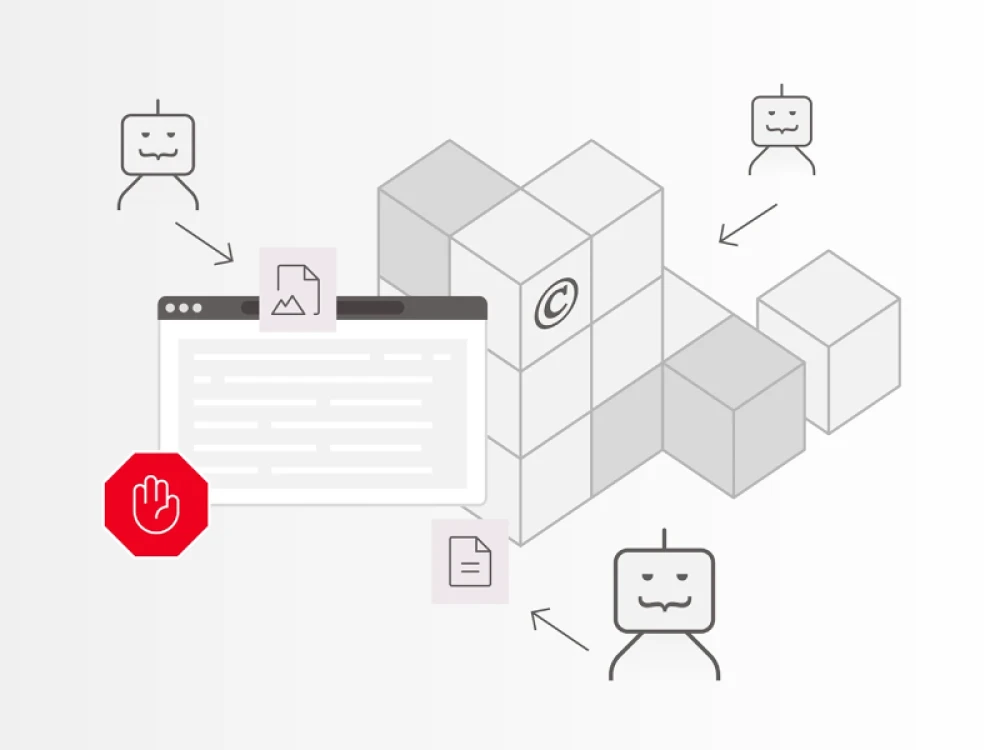According to McKinsey, AI is defined as “a machine’s ability to perform the cognitive functions we usually look to associate with human minds.” AI is now able to do what humans have had to do in the past: content creation, ideation, copywriting, and so much more. This article will discuss the benefits and risks of implementing AI into your content strategies, as well as point to how others are using it.
Artificial Intelligence (AI) has become a controversial topic amongst content creators. On one hand, it can expedite content processes like no other technology, but on the other, it’s a disruptive technology that can take away the “human element” of content. However, it all depends on how you use it.
AI can have a positive impact on digital strategies and can play a pivotal role in your content governance. For one, AI automates tasks and sorts through your data at a lightning pace, further enhancing the general customer experience. According to Gartner research, generative AI delivers high-value artifacts (those being images, words, designs, etc.), and supports basic tasks, such as editing, resizing images, and other similar tasks. But should you really entrust AI with tasks, such as content creation, ideation, image selection for optimization and searchability?
For those who might have used it already, they’ve seen first-hand the proven impact AI has on content development and the general customer experience. Some content management systems have been using some form of AI for years, including Brightspot. So how are content creators using AI in their CMS, and what should look out for?
Search engine optimization
Your SEO efforts are very important to reaching your target audience, so running your content through AI tools can help with keywords, common searches and meta description writing. These AI tools can also help in scanning your older content to refresh it with modern SEO-friendly titles, descriptions, headings and keywords.
SEO optimization goes hand-in-hand with your image optimization. According to Gartner, Generative AI can support image creation, from text to synthetic generation of images. Using AI to generate up-to-date images for both image optimization and SEO purposes can eliminate delays of creative shoots, as well as the ability to develop new content without typical production constraints teams may endure.
Accessibility
Having AI tools can help with scanning your site and adding accessible enhancements, such as adding alt text to all your images within your CMS, offering a text description of the image that can be read aloud by a screen reader for those who are visually impaired. It can make suggestions to where you may benefit from adding speech recognition, facial recognition, or text processing capabilities.
AI can also assist with translation. If your team wants to reach a broader audience, AI tools are available to assist in automatically translating text and audience recordings from one language to another. This can have a great impact on the general customer experience as a whole.
Natural language generation
According to Gartner, generative AI assists with natural language generation (NLG), being short-form and long-form text generation.
Short-form can be email subject lines, body copy, web content, and other types of content that can be easily customized. The most common used short-form generation are titles and descriptions (mainly for SEO optimization purposes).
For long-form content, AI can be used to create marketing copy, news stories and articles.
Of course, this poses a few risks, such as lack of variation. Even though AI can generate these forms of text generation, creative teams must still implement the human aspect of creative writing to follow their organization’s brand guidelines. While it makes it easier, teams should continue to look at how their customers engage with their content and adapt with it.
Experiment and implement
You don’t want to just integrate AI tools without knowing how it will affect you. Gartner’s research says to start with a pilot project that will allow you to gather metrics for success. This can include how much time you spend/save, drafts, assets, and other necessary metrics. Through trial and error, you’ll eventually learn how it may benefit, or, in turn, hinder you.
Monitoring your content
It’s important that your site lives up to your organization’s standards, which means that you need to constantly monitor your content to flag anything that goes against your site standards. With AI data protection and privacy, it’s vital for organizations to remain compliant with regulatory requirements.
When assessing AI content governance, you should ask yourself what the risks are with using AI protection and privacy. There are AI tools, such as Amazon Rekognition, that can easily scan and analyze text, images and videos to see if there are any red flags in your content.
Using AI with a purpose
There was a time that many people, likely including yourself, thought AI the beginning of the end. However, when used correctly and with a purpose, it can be an attractive tool to use when wanting to reach a broader audience. It boils down to ethics and how you use it. After all, you’re using AI to make your content team’s life easier.
Well thought-out strategies using AI automation tools can benefit you in many ways, and you’ll be rewarded for your efforts. Be sure to weigh the benefits and risks of deploying AI, and make sure they’re serving a detailed purpose. The more you can automate the back end of your CMS using AI tools, the more time you can spend on higher-level content strategy.
How should companies approach the introduction of AI into their content programs?
Integrating AI tools necessitates a thoughtful approach to experimentation and implementation. Gartner’s research underscores the importance of commencing with pilot projects to gather metrics for success. These metrics encompass various aspects, including time efficiency, draft quality, and asset utilization. Through iterative experimentation, organizations can ascertain the efficacy of AI tools and their potential impact on content strategy.
However, before even gathering the data, companies must agree on if, where and how AI fits within their content governance framework. Questions to ask and answer include:
- Strategic alignment: Does AI align with our overall content strategy and business objectives? How does integrating AI into content governance contribute to our long-term goals?
- Resource allocation: What resources (financial, human, technological) are required to implement and maintain AI-driven content governance? Do we have the necessary expertise or do we need to invest in training or hiring AI specialists?
- Risk assessment: What are the potential risks and challenges associated with AI adoption in content governance? How can we mitigate risks related to data privacy, security, accuracy, and ethical considerations?
- Impact on content workflows: How will AI integration affect existing content creation, review and distribution processes? What changes need to be made to accommodate AI tools within those workflows and approval processes?
- Quality assurance: How do we ensure that AI-generated content meets our quality standards and brand guidelines? What measures will be put in place to validate the accuracy and authenticity of AI-generated content?
- Regulatory compliance: Are there any legal or regulatory requirements that govern the use of AI in content governance? How do we ensure compliance with data protection laws and regulations when using AI?
- User experience: How will AI-driven content governance impact the overall user experience? Will AI enhancements improve accessibility, personalization and engagement for our audience?
- Measurement and evaluation: What key performance indicators (KPIs) will be used to assess the effectiveness of AI-driven content distribution? How do we measure the ROI and business impact of AI integration in content governance?
- Ethical considerations: What ethical guidelines and principles should govern the use of AI in content creation and distribution? How can we ensure transparency, fairness and accountability in AI algorithms and decision-making processes?
- Long-term sustainability: How scalable and adaptable is our AI-driven content governance framework to future changes and advancements in technology? What steps will be taken to continuously optimize and refine our AI strategies for long-term sustainability?
As is clear from the above, it’s important that your site lives up to your organization’s standards, which means that you need to constantly monitor your content to flag anything that goes against your site standards. Furthermore, given the data protection and privacy concerns around AI, it’s vital for organizations to remain compliant with all regulatory requirements.









